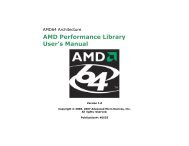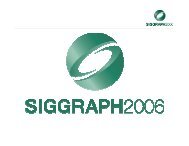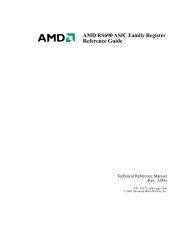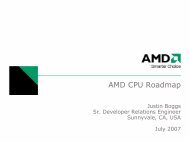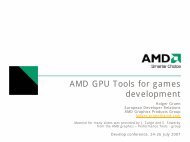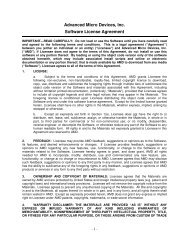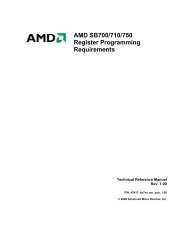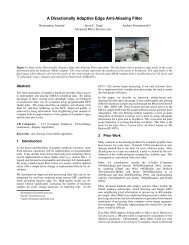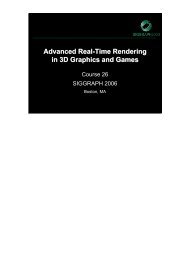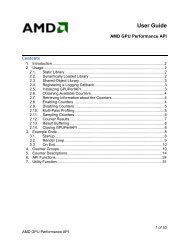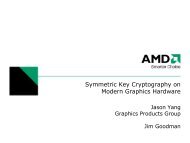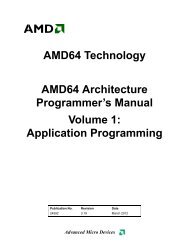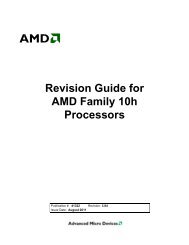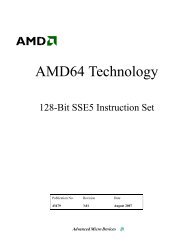Entering the Golden Age of Heterogeneous Computing ? C-DAC ...
Entering the Golden Age of Heterogeneous Computing ? C-DAC ...
Entering the Golden Age of Heterogeneous Computing ? C-DAC ...
You also want an ePaper? Increase the reach of your titles
YUMPU automatically turns print PDFs into web optimized ePapers that Google loves.
1<br />
AMD<br />
<strong>Entering</strong> <strong>the</strong> <strong>Golden</strong> <strong>Age</strong> <strong>of</strong> <strong>Heterogeneous</strong> <strong>Computing</strong><br />
Michael Mantor<br />
Senior GPU Compute Architect / Fellow<br />
AMD Graphics Product Group<br />
michael.mantor@amd.com
The 4 Pillars <strong>of</strong> massively parallel compute <strong>of</strong>fload<br />
•Performance<br />
•Power<br />
•Price<br />
• Programming Models<br />
2<br />
M Moore’s ’ L Law 2 2x < 18 Months M th<br />
Frequency\Power\Complexity Wall<br />
Parallel Opportunity for growth<br />
GPU is <strong>the</strong> first successful massively parallel<br />
COMMODITY architecture with a programming model<br />
that managed managed g to tame 1000’s <strong>of</strong> p parallel threads in<br />
hardware to perform useful work efficiently
Quick recap <strong>of</strong> where we are – Perf, Power, Price<br />
ATI Radeon X1800 XT<br />
ATI Radeon X1900 XTX ATI Radeon X1950 PRO<br />
ATI Radeon Radeon HD 2900 XT<br />
4x Performance/w and<br />
Performance/mm² in a<br />
year<br />
ATI Radeon HD 3850<br />
ATI Radeon<br />
HD 4850<br />
3 Source <strong>of</strong> GigaFLOPS per watt: maximum <strong>the</strong>oretical performance divided by maximum board power.<br />
Source <strong>of</strong> GigaFLOPS per $: maximum <strong>the</strong>oretical performance divided by price as reported on www.buy.com as <strong>of</strong> 9/24/08
ATI RadeonHD 4850<br />
4<br />
Designed to Perform in Single Slot<br />
SP Compute Power 1.0 T-FLOPS<br />
DP Compute Power<br />
Core Clock Speed<br />
Stream Processors<br />
Memory Type<br />
Memory Capacity<br />
Max Board Power<br />
Memory Bandwidth<br />
200 G-FLOPS<br />
625 Mhz<br />
800<br />
GDDR3<br />
512 MB<br />
110W<br />
64 GB/Sec
ATI RadeonHD 4870<br />
First Graphics p with GDDR5<br />
5<br />
SP Compute Power 1.2 T-FLOPS<br />
DP Compute Power<br />
Core Clock Speed<br />
Stream Processors<br />
Memory Type<br />
Memory Capacity<br />
Max Max Board Power<br />
Memory Bandwidth<br />
240 G-FLOPS<br />
750 Mhz<br />
800<br />
GDDR5 3.6Gbps<br />
512 MB<br />
160 W<br />
115.2 GB/Sec
ATI RadeonHD 4870 X2<br />
Incredible Balance <strong>of</strong> Performance, , Power, , Price<br />
6<br />
Compute Power 2.4 TFLOPS<br />
DP Compute Power 240 G-FLOPS<br />
Core Clock Speed 750 Mhz<br />
Stream Processors<br />
Memory Type<br />
Memory Capacity<br />
Max Max Board Power<br />
Memory Bandwidth<br />
1600<br />
GDDR5 3.6Gbps<br />
2 GB<br />
285W<br />
230 GB/Sec
AMD FireStream 9250<br />
• AMD’s Second Generation Stream <strong>Computing</strong> p g Product<br />
• Single PCI Slot<br />
• Computational Power<br />
• One TT-FLOPS FLOPS Single Precision Float<br />
• 200 GFLOPS Double Precision<br />
• 1 GB GDDR3<br />
• 150 Watts 8GFLOPS/Watt<br />
• Familiar 32 and 64 bit Linux® and Windows® Environment<br />
• Stream s<strong>of</strong>tware supports multiple GPUs per system<br />
• Brook+ (Open Source C-level language & Compiler)<br />
• GPU Shader Analyzer y<br />
• AMD Code Analyst<br />
• AMD’s Compute Abstraction Layer (CAL)<br />
7
Crossfire FragBox QuadFire @ Falcon Northwest<br />
8<br />
• QuadFire 2x ATI RadeonTM Q<br />
4870X2 2 GB<br />
• 3200 Single Precision Stream Processer<br />
• Or 160 DP units with 160 SP units
Rapid Advances for Compute<br />
9<br />
TToday d !!<br />
Meet <strong>the</strong> ATI Radeon HD48xx<br />
Architecture
Terascale Unified Graphics Engine<br />
• 800 highly optimized stream<br />
processing units<br />
• New Unified SIMD core layout<br />
• Optimized texture units<br />
• New texture cache design<br />
• New memory architecture<br />
• OOptimized ti i d render d bback-ends k d f for<br />
fast anti-aliasing performance<br />
• Enhanced geometry shader &<br />
tessellator performance<br />
10
Simple View <strong>of</strong> a Unified Data<br />
Parallel Throughput Machine<br />
• Highly threaded to hide latency for light<br />
ALU lloads d and d I/O constrained t i d Apps A<br />
Work Dispatcher<br />
– Hardware has support for ~16,000 shader<br />
program invocations Unified Shader Core<br />
– Hardware has register & resources for each<br />
invocation<br />
• I/O bound with low ALU count<br />
11<br />
– 16 arrive per clock,<br />
– 16 leave per clock<br />
– 40 threads issue fetch per clock<br />
– Fetch latency<br />
300 clks latency 4,800 threads<br />
1 dependant fetch 9,600 threads<br />
2 dependant fetch 14,400 threads<br />
PCIE<br />
Host<br />
Interface<br />
800 hardware units<br />
>200 Clocks fetch latency<br />
16,384 (threads)<br />
Output Crossbar<br />
Memory<br />
Fetch<br />
Crossbar<br />
& Caches
ATI Radeon HD 4800 Series Architecture<br />
• 10 SIMD cores<br />
– Each with 80 32-bit Stream Processing<br />
Units<br />
(800 total)<br />
– Dual Identity – 16 64-bit & 16 32-bit<br />
Stream Processing Units<br />
• 40 Texture Units<br />
• 115+ GB/sec GDDR5 memory interface<br />
ATI<br />
ATI<br />
Radeon Radeon Difference<br />
HD 3870 HD 4870<br />
Die Size 190 mm 2<br />
260 mm 2<br />
1.4x<br />
Memory 72 GB/sec 115 GB/sec 1.6x<br />
AA Resolve 32 64 2x<br />
Z/Stencil 32 64 2x<br />
Texture 16 40 2.5x<br />
Shader 320 800 2.5x<br />
12<br />
Texture<br />
Units<br />
GDDR5 Memory Interface<br />
SIMD<br />
Cores<br />
PCI Express Bus Interface<br />
UVD &<br />
Display<br />
Controllers
SIMD Cores<br />
• Each core:<br />
– Includes 80 scalar stream processing units in total + 16KB<br />
Local Data Share<br />
– Has its own control logic and runs from a shared set <strong>of</strong> threads<br />
– Has 4 dedicated texture units + L1 cache<br />
– Communicates with o<strong>the</strong>r SIMD cores via 16KB global g data<br />
share<br />
• New design allows texture fetch capability to scale efficiently with<br />
shader power, maintaining 4:1 ALU:TEX ratio<br />
13
Stream Processing Units<br />
• 40% increase in performance per<br />
mm2* mm<br />
• More aggressive clock gating for<br />
imp improved o ed Pe Performance fo mance per pe Watt<br />
•Fast double precision p processing<br />
p g<br />
(240 GigaFLOPS)<br />
• Integer bit shift operations<br />
for all units<br />
(12.5x improvement * (12.5x improvement )<br />
14<br />
Source <strong>of</strong> performance per mm 2 : maximum <strong>the</strong>oretical performance divided by surface area <strong>of</strong> aSIMD<br />
Source <strong>of</strong> 12.5x improvement: for ATI Radeon HD 3800 Series 4 SIMDs x 16 shift operations per SIMD = 64 shift operations.<br />
For ATI Radeon 4800 Series 10 SIMDs x 80 shift operations = 800 shift operations.
Texture Units<br />
• Streamlined design<br />
– 70% increase in performance/mm 2*<br />
• More performance<br />
– Double <strong>the</strong> texture cache bandwidth<br />
<strong>of</strong> <strong>the</strong> ATI RadeonTM <strong>of</strong> <strong>the</strong> ATI Radeon HD 3800 SERIES<br />
– 2.5x increase in 32-bit filter rate<br />
– 1.25x increase in 64-bit filter rate<br />
– U Up to t 160 fetches f t h per clock l k<br />
ATI<br />
Radeon HD<br />
4870<br />
ATI<br />
Radeon HD<br />
3870<br />
Peak 32-bit texture fetch rate<br />
49.6 Gtex/s<br />
120 Gtex/s<br />
15 Source <strong>of</strong> performance per mm2 : maximum <strong>the</strong>oretical performance divided by surface area <strong>of</strong> <strong>the</strong> texture units
Texture Units<br />
• New cache design<br />
– L2s aligned with memory channels<br />
– L1s store unique data per SIMD<br />
2.5x increase aggregate L1 *<br />
– Separate vertex cache<br />
– Increased bandwidth<br />
16<br />
Up to 480 GB/sec <strong>of</strong> L1 texture<br />
fetch bandwidth<br />
Up to 384 GB/sec between L1 & L2<br />
* Comparing ATI Radeon TM HD 4800 series and ATI Radeon TM HD 3800 series
Render Back-Ends<br />
• Focus on improving AA performance per mm 2<br />
– Doubled peak rate for depth/stencil ops to<br />
64 per clock<br />
– Doubled AA peak fill rate for 32-bit & 64-bit color *<br />
Doubled AA peak fill rate for 32 bit & 64 bit color<br />
– Doubled non-AA peak fill rate for 64-bit color<br />
• Supports both fixed function (MSAA) and<br />
programmable p g ( (CFAA) ) modes<br />
No MSAA<br />
2x/4x<br />
MSAA<br />
Color<br />
32bit<br />
ATI Radeon TM<br />
HD 3800<br />
series<br />
ATI Radeon TM<br />
HD 4800<br />
series<br />
Difference<br />
16 pix/clk 16 pix/clk 1x<br />
8 pix/clk 16 pix/clk 2x<br />
8x MSAA 4 pix/clk 8 pix/clk 2x<br />
No MSAA<br />
2x/4x<br />
MSAA<br />
64-<br />
bit<br />
8 pix/clk 16 pix/clk 2x<br />
8 pix/clk p 16 pix/clk p<br />
2x<br />
8x MSAA 4 pix/clk 8 pix/clk 2x<br />
Depth/stencil only 32 pix/clk 64 pix/clk 2x<br />
17<br />
* Comparing ATI Radeon TM HD 4800 series and ATI Radeon TM HD 3800 series
Memory Controller Architecture<br />
• New distributed design with hub<br />
• Controllers distributed around periphery<br />
<strong>of</strong> chip, adjacent to primary bandwidth<br />
consumers<br />
• Memory tiling & 256-bit interface allows<br />
reduced latency, silicon area, and power<br />
consumption<br />
• Hub handles relatively low bandwidth<br />
traffic<br />
18<br />
PCI Express® CrossFireXTM – PCI Express®, CrossFireX interconnect<br />
TM interconnect,<br />
UVD2, display controllers,<br />
intercommunication)
1<br />
9<br />
ATI Radeon HD 4870 Computation Highlights<br />
• >100 GB/s memory bandwidth<br />
– 256b GDDR5 interface<br />
• Targeted for handling thousands <strong>of</strong><br />
simultaneous lightweight threads<br />
• 800 (160x5) stream processors<br />
19<br />
– 640 (160x4) basic units<br />
(FMAC, ADD/SUB, CMP, etc.)<br />
~1.2 TFlops <strong>the</strong>oretical peak<br />
– 160 enhanced transcendental units<br />
(adds COS, LOG, EXP, RSQ, etc.)<br />
– Support for INT/UINT in all units<br />
(ADD/SUB, AND, XOR, NOT, OR,<br />
etc.)<br />
– 64-bit double precision FP support<br />
1/5 single precision rate<br />
(~240GFlops <strong>the</strong>oretical<br />
performance)<br />
4 SIMDs -> 10 SIMDs<br />
–2.5X peak <strong>the</strong>oretical performance<br />
increase over ATI Radeon 3870<br />
–~1.2 TFlops FP32 <strong>the</strong>oretical peak<br />
–~240 GFlops FP64 <strong>the</strong>oretical peak<br />
Scratch-pad memories<br />
–16KB per SIMD (LDS)<br />
–16KB 16KB across SIMDs SIMD (GDS)<br />
Synchronization capabilities<br />
Compute Shader<br />
–Launch work without rasterization<br />
– “Linear” Linear scheduling<br />
–Faster thread launch
Performance<br />
20<br />
800%<br />
700%<br />
600%<br />
500%<br />
400%<br />
300%<br />
200%<br />
100%<br />
0%<br />
• AMD Core Math Library (3870)<br />
• FFT<br />
SGEMM - 300 GFLOPS<br />
DGEMM - 137 GFLOPS<br />
Radeon HD 3870 Systems Systems, Inc.) Inc)<br />
Radeon HD 4870<br />
305 GFLOPS (Mercury Computer<br />
Based on internal testing at AMD Performance Labs on reference platform. Configuration:<br />
Intel Q6600 (2.4 GHz), 2GB DDR3, ASUS P5E3 Deluxe mo<strong>the</strong>rboard, Windows Vista®<br />
Ultimate (32-bit). For ATI Radeon GPUs: CAL 1.01, Matrix multiply (CAL optimized<br />
implementation, available in SDK), FFT (CAL optimized implementation), ATI Catalyst 8.6<br />
s<strong>of</strong>tware. Quoted peaks are based on manufacturer claims. All results normalized to ATI<br />
Radeon HD 3870 GPU.
ATI Radeon HD 4800 Series Stream Architecture<br />
• Several enhancements done for stream computing<br />
• Fast compute dispatch<br />
• Local /Global data shares<br />
• Increased Integer Processing Abilities<br />
• Fast Mem import/export<br />
• Significant f increases in performance f on many<br />
21<br />
important stream processing workloads
<strong>Age</strong>nda<br />
22<br />
Stream SDK strategy update<br />
Stream implication for pr<strong>of</strong>essional<br />
and consumer markets<br />
Brook+<br />
AMD’s Compute Abstraction Layer (CAL)<br />
DirectX® 11 11.0 0 Compute Shader Introduction<br />
OpenCL p Introduction<br />
Stream processing demos
Stream SDK Momentum<br />
•AMD was <strong>the</strong> first company to <strong>of</strong>fer a freely<br />
downloadable, open set <strong>of</strong> programming<br />
tools for GPGPU programming<br />
•Adoption <strong>of</strong> Stream SDK, launched in<br />
2006, continues to grow<br />
•Hundreds <strong>of</strong> topics have been posted and<br />
discussed on <strong>the</strong> AMD Stream Developer<br />
Forum, making it <strong>the</strong> most active developer<br />
forum at AMD<br />
•http://developer.amd.com/devforum<br />
23
Key imperatives for <strong>the</strong> growth <strong>of</strong> an application<br />
eco-system y<br />
• Industry standard Programming models<br />
• Tools, Libraries, Middleware<br />
• Services<br />
• Research community and early adopters<br />
24
AMD Stream Processing Strategy<br />
25<br />
Applications<br />
(Game <strong>Computing</strong>,<br />
Video <strong>Computing</strong>, Scientific<br />
<strong>Computing</strong>, Productivity)<br />
Tools, Libraries, Middleware<br />
(ACML, Brook+, Cobra,<br />
RapidMind, Havok etc)<br />
Industry Standard Interfaces<br />
(OpenCL, DirectX 11®, etc.)<br />
Compute Abstraction Layer (CAL)<br />
AMD Stream Platform
Single Programming Environment<br />
Top to bottom support <strong>of</strong> stream applications on AMD GPUs<br />
26<br />
Pr<strong>of</strong>essional<br />
Consumer<br />
AMD FireStream<br />
9250 Graphics<br />
1 st GPU to Break 1Tflops barrier<br />
8 SP GFLOPS per watt<br />
AMD FireStream<br />
9170 Graphics<br />
1 st GPU w/Double Precision FP<br />
ATI FireGL Graphics &<br />
ATI FirePro Graphics<br />
ATI Radeon HD Graphics<br />
2H 2008<br />
http://ati.amd.com/products/streamprocessor/specs.html<br />
Swift APU (planned)<br />
1H 2009
27<br />
Brook+<br />
<strong>Computing</strong> Language
What is Brook+?<br />
Brook is an extension to <strong>the</strong> C-language for stream programming<br />
originally g y developed p by y Stanford Universityy<br />
Brook+ is an implementation by AMD <strong>of</strong> <strong>the</strong> Brook GPU spec on<br />
AMD's compute abstraction layer with some enhancements<br />
Asynchronous CPU->GPU transfers (GPU->CPU still synchronous)<br />
Li Linux®, ® Windows Wi d Vi Vista®, t ® Mi Micros<strong>of</strong>t® ft® Windows® Wi d ® XP 32 & 64-bit 64 bit<br />
Extension Mechanism<br />
28<br />
Allow ASIC specific features to be exposed without ‘sullying’ core<br />
language
2<br />
9<br />
Simple Example<br />
kernel void sum(float a, float b, out float c)<br />
{<br />
c = a + b;<br />
}<br />
int main(int argc, char** argv)<br />
{<br />
int i, j;<br />
float a;<br />
float b
3<br />
0<br />
Brook+ kernels<br />
kernel void sum(float a, float b, out float c)<br />
{<br />
c = a + b;<br />
}<br />
Standard Streams - implicit and<br />
predictable access pattern<br />
int main(int argc, char** argv)<br />
{ kernel void sum(float a[], float b[], out float c)<br />
{ int i, j;<br />
float int idx a;<br />
c float c = a[idx] b; b[idx];<br />
Ga<strong>the</strong>r Streams - dynamic read<br />
} float c;<br />
kernel<br />
float<br />
void<br />
input_a[10][10];<br />
sum(float a, float b, out float c[])<br />
{<br />
float input_b[10][10];<br />
int<br />
float<br />
idx<br />
input input_c[10][10];<br />
= index<strong>of</strong>(c);<br />
c[10][10];<br />
c[idx] = a + b;<br />
}<br />
for(i=0; i
3<br />
1<br />
Brook+ Compiler<br />
Converts Brook+ files into C++ code. Kernels, written in C, are<br />
compiled to AMD’s IL code for <strong>the</strong> GPU or C code for <strong>the</strong> CPU.<br />
brcc<br />
brt<br />
31<br />
31<br />
Integrated<br />
Stream Kernel<br />
& CPU Program<br />
CPU, Stream<br />
Code Splitter<br />
CPU Code<br />
(C) ( )<br />
CPU Emulation Code<br />
(C++)<br />
Kernel<br />
Compiler<br />
Stream Runtime (CAL)<br />
AMD Stream Processor<br />
Device Code (IL)<br />
CPU Backend GPU Backend
3<br />
2<br />
Brook+ Compiler<br />
IL code is executed on <strong>the</strong> GPU. The backend is written in CAL.<br />
brcc<br />
brt<br />
32<br />
32<br />
Integrated<br />
Stream Kernel<br />
& CPU Program<br />
CPU, Stream<br />
Code Splitter<br />
CPU Code<br />
(C) ( )<br />
CPU Emulation Code<br />
(C++)<br />
Kernel<br />
Compiler<br />
Stream Runtime (CAL)<br />
AMD Stream Processor<br />
Device Code (IL)<br />
CPU Backend GPU Backend
Improving and Evolving Brook+<br />
• Improve and evolve Brook+<br />
33<br />
programming language, compiler and<br />
runtime, including: Aims to provide a<br />
improved error handling<br />
stable, t bl high- hi h<br />
performance<br />
data transfer optimizations<br />
platform for<br />
accelerating l ti<br />
C++ runtime API<br />
applications today,<br />
access to CAL-level CAL level functionality<br />
paving migration path<br />
towards t ttowards d<br />
OpenCL OpenCL/DirectX®<br />
Compute
34<br />
CAL<br />
Compute Abstraction Layer
Compute Abstraction Layer (CAL) goals<br />
Expose relevant compute aspects <strong>of</strong> <strong>the</strong> GPU<br />
CCommand d P Processor<br />
Data Parallel Processor(s)<br />
Memory Controller<br />
Hide all o<strong>the</strong>r graphics-specific features<br />
Provide direct & asynchronous communication to device<br />
Eliminate driver implemented procedural API<br />
35<br />
35<br />
3<br />
5<br />
Push policy decisions back to application<br />
Remove constraints imposed by graphics APIs
CAL Highlights<br />
Memory managed<br />
D Don’t ’t have h to t manually ll maintain i t i <strong>of</strong>fsets, ff t etc t<br />
Asynchronous DMA: CPU➙GPU, GPU➙GPU, GPU➙CPU<br />
Multiple GPUs can share <strong>the</strong> same “system” system memory<br />
Core CAL API is device agnostic<br />
Enables multi-device optimizations<br />
e.g. Multiple GPUs working toge<strong>the</strong>r concurrently<br />
Multiple GPUs show up as multiple CAL devices<br />
EExtensions t i t to CAL provide id opportunities t iti f for device d i<br />
specific optimization<br />
36
Commitment to Industry Standards – AMD Believes:<br />
Industry standards and open collaboration is key to driving<br />
development <strong>of</strong> stream applications and ensuring <strong>the</strong>se applications<br />
work on <strong>the</strong> broadest range <strong>of</strong> hardware<br />
Proprietary Solutions<br />
• Helps to drive experimentation <strong>of</strong> new<br />
technology<br />
• Appropriate when no standards in place<br />
37<br />
Industry Standards<br />
• As hardware and s<strong>of</strong>tware evolves, key<br />
to making it accessible in a unified way<br />
• Stream processing has evolved to a<br />
point where proprietary solutions are not<br />
helping to drive broader technology<br />
acceptance
38<br />
DirectX® DirectX® 11<br />
Compute Shaders<br />
An evolving processing model for GPUs<br />
DirectX® 11.0 Siggraph2008 slides courtesy <strong>of</strong> Chas Boyd Architect @ Micros<strong>of</strong>t<br />
Windows Desktop and Graphics Technology
Introducing: <strong>the</strong> Compute Shader<br />
• A new processing model for GPUs<br />
– Data–parallel p pprogramming g g for mass market client apps pp<br />
• Integrated with Direct3D<br />
– For efficient inter inter-op op with graphics in client scenarios<br />
• Supports more general constructs than before<br />
– Cross thread data sharing<br />
– Un-ordered access I/O operations<br />
• Enables more general data structures<br />
– Irregular g arrays, y , trees, , etc.<br />
• Enables more general algorithms<br />
– Far beyond shading<br />
DirectX® 11.0 Siggraph2008 slides courtesy <strong>of</strong> Chas Boyd Architect @ Micros<strong>of</strong>t<br />
Windows Desktop and Graphics Technology
Target: Interactive Graphics/Games<br />
• Image/Post processing:<br />
– Image Reduction, Histogram, Convolution, FFT<br />
• Eff Effect t physics h i<br />
– Particles, smoke, water, cloth, etc.<br />
• Advanced renderers:<br />
– A-Buffer/OIT, Reyes, Ray-tracing, radiosity, etc.<br />
• Game play pla physics, ph sics AI AI, etc etc.<br />
• Production pipelines<br />
DirectX® 11.0 Siggraph2008 slides courtesy <strong>of</strong> Chas Boyd Architect @ Micros<strong>of</strong>t<br />
Windows Desktop and Graphics Technology
Target: g Media Processing g<br />
• Video:<br />
– Transcode Transcode, Super Resolution Resolution, etc etc.<br />
• Photo/imaging: g g<br />
– Consumer applications<br />
• Non-client scenarios:<br />
– HPC, server workloads, etc.<br />
DirectX® 11.0 Siggraph2008 slides courtesy <strong>of</strong> Chas Boyd Architect @ Micros<strong>of</strong>t<br />
Windows Desktop and Graphics Technology
Component Relationships<br />
Relationships<br />
Domain<br />
Libraries<br />
Applications<br />
Domain<br />
Languages g g<br />
Compute Languages<br />
Media playback or processing,<br />
media UI, recognition, etc.<br />
Accelerator, Brook+, Rapidmind, Ct<br />
MKL, ACML, cuFFT, D3DX, etc.<br />
DirectX® 11.0 Compute,<br />
CUDA CUDA, CAL CAL, OpenCL OpenCL,<br />
LRB Native, etc.<br />
Processors<br />
CPU, , GPU, , Larrabee<br />
nVidia, Intel, AMD, S3, etc.<br />
DirectX® 11.0 Siggraph2008 slides courtesy <strong>of</strong> Chas Boyd Architect @ Micros<strong>of</strong>t<br />
Windows Desktop and Graphics Technology
Compute p Shader Features<br />
• Predictable Thread Invocation<br />
– RRegular l arrays <strong>of</strong> f th threads: d 11-D, D 22-D, D 33-DD – Don’t have to ‘draw a quad’ anymore<br />
• Shared registers between threads<br />
– Reduces register pressure<br />
– Can eliminate redundant compute and i/o<br />
• Scattered Writes<br />
– Can read/write arbitrary data structures<br />
– Enables new classes <strong>of</strong> algorithms<br />
– Integrates with Direct3D resources<br />
DirectX® 11.0 Siggraph2008 slides courtesy <strong>of</strong> Chas Boyd Architect @ Micros<strong>of</strong>t<br />
Windows Desktop and Graphics Technology<br />
4<br />
3
Integrated g with Direct3D<br />
• Fully y supports pp all Direct3D resources<br />
• Targets graphics/media data types<br />
• Evolution <strong>of</strong> DirectX® HLSL<br />
• Graphics pipeline updated to emit general<br />
data structures via addressable writes<br />
• Which can <strong>the</strong>n be manipulated by compute<br />
shader<br />
• And <strong>the</strong>n rendered by Direct3D again<br />
DirectX® 11.0 Siggraph2008 slides courtesy <strong>of</strong> Chas Boyd Architect @ Micros<strong>of</strong>t<br />
Windows Desktop and Graphics Technology
Integration with Graphics Pipeline<br />
Input Assembler<br />
Vertex Shader<br />
Tessellation<br />
Geometry Shader<br />
RRasterizer i<br />
Pixel Shader<br />
Output Merger<br />
Scene Image<br />
Data Structure<br />
Compute Shader<br />
DirectX® 11.0 Siggraph2008 slides courtesy <strong>of</strong> Chas Boyd Architect @ Micros<strong>of</strong>t<br />
Windows Desktop and Graphics Technology<br />
• Render scene<br />
• Write out scene image<br />
• Use Compute for image<br />
post post-processing<br />
processing<br />
• Output final image<br />
Final Image
Memory y Objects j<br />
• DXGI Resources<br />
– Used for textures, images, vertices, hulls, etc.<br />
– Enables out-<strong>of</strong>-bounds memory checking<br />
• Returns 0 on reads<br />
• Writes are No-Ops<br />
– Improves p security, y, reliability y <strong>of</strong> shipped pp code<br />
• Exposed as HLSL ‘Resource Variables’<br />
– Declared in <strong>the</strong> language as data objects<br />
DirectX® 11.0 Siggraph2008 slides courtesy <strong>of</strong> Chas Boyd Architect @ Micros<strong>of</strong>t<br />
Windows Desktop and Graphics Technology
Optimized p I/O Intrinsics<br />
• Textures & Buffers<br />
– RWTexture2D RWTexture2D, RWBuffer<br />
– Act just like existing types<br />
• S Structured I/O /O<br />
– RWStructuredBuffer<br />
– StructuredBuffer (read-only)<br />
– Template type can be any struct definition<br />
• Fast Structured I/O<br />
– AAppendStructuredBuffer, dSt t dB ff CConsumeStructuredBuffer St t dB ff<br />
– Work like streams<br />
– Do not preserve ordering<br />
DirectX® 11.0 Siggraph2008 slides courtesy <strong>of</strong> Chas Boyd Architect @ Micros<strong>of</strong>t<br />
Windows Desktop and Graphics Technology
Atomic Operator Intrinsics<br />
Enable basic operations w/o lock/contention:<br />
InterlockedAdd( rVar, val );<br />
InterlockedMin( rVar, val );<br />
InterlockedMax( ( rVar, , val );<br />
InterlockedOr( rVar, val );<br />
InterlockedXOr( rVar, val );<br />
InterlockedCompareWrite( p<br />
rVar, val );<br />
InterlockedCompareExchange( rVar, val );<br />
DirectX® 11.0 Siggraph2008 slides courtesy <strong>of</strong> Chas Boyd Architect @ Micros<strong>of</strong>t<br />
Windows Desktop and Graphics Technology
Reduction Compute Code<br />
Buffer Values;<br />
OutputBuffer p Result; ;<br />
ImageAverage()<br />
{<br />
groupshared uint Total; // Total so far<br />
groupshared uint Count; // Count added<br />
float3 vPixel = load( sampler, sv_ThreadID );<br />
float fLuminance = dot( vPixel, LUM_VECTOR );<br />
uint value = fLuminance*65536;<br />
InterlockedAdd( Count, 1 );<br />
InterlockedAdd( ( Total, , value );<br />
GroupMemoryBarrier(); // Let all threads in group complete<br />
. . . .<br />
DirectX® 11.0 Siggraph2008 slides courtesy <strong>of</strong> Chas Boyd Architect @ Micros<strong>of</strong>t<br />
Windows Desktop and Graphics Technology
Summary<br />
• DirectX® 11 11.0 0 Compute Shader expected to<br />
deliver <strong>the</strong> performance <strong>of</strong> 3-D games to new<br />
applications li ti<br />
• Tight integration between computation and<br />
rendering<br />
• Scalable parallel processing model<br />
– CCode d should h ld scale l ffor several l generations ti<br />
DirectX® 11.0 Siggraph2008 slides courtesy <strong>of</strong> Chas Boyd Architect @ Micros<strong>of</strong>t<br />
Windows Desktop and Graphics Technology
51<br />
OpenCL<br />
Open <strong>Computing</strong> Language<br />
Siggraph2008 slides courtesy <strong>of</strong> Aaftab Munshi<br />
AArchitect hit t @ @AApple l & Kh Khronos OOpenCL CLWWorkgroup k Member<br />
M b
Update on OpenCL<br />
• Khronos OpenCL working group making aggressive progress<br />
( (www.khronos.org)<br />
kh )<br />
• Contributing Industry leaders <strong>of</strong> task/data parallel processors<br />
• Standardize framework and language for multiple<br />
heterogeneous g pprocessors<br />
• PC developers are expected to have early version in Q1 2009<br />
• Based on a proposal by Apple<br />
52<br />
– OpenCL Parallel <strong>Computing</strong> on GPU and CPU<br />
(M (Munshi hi @ Si SigGraph G h 2008)<br />
– Developed in collaboration with industry leaders
OpenCL p – A Sneak Preview<br />
Beyond Programmable Shading Fundamentals Siggraph2008<br />
slides courtesy <strong>of</strong> Aaftab Munshi
Design g Goals <strong>of</strong> OpenCL p<br />
• Use all computational resources in system<br />
– GPUs and CPUs as peers<br />
– Data- and task- parallel compute model<br />
• Efficient parallel programming model<br />
– Based on C<br />
– Abstract <strong>the</strong> specifics <strong>of</strong> underlying hardware<br />
• Specify accuracy <strong>of</strong> floating floating-point point computations<br />
– IEEE 754 compliant rounding behavior<br />
– Define maximum allowable error <strong>of</strong> math functions<br />
• Drive future hardware requirements<br />
Beyond Programmable Shading Fundamentals Siggraph2008<br />
slides courtesy <strong>of</strong> Aaftab Munshi
OpenCL p S<strong>of</strong>tware Stack<br />
• Platform Layer<br />
– query and select compute devices in <strong>the</strong> system<br />
– initialize a compute device(s)<br />
– create t compute t contexts t t and d work-queues k<br />
• Runtime<br />
– resource management<br />
– execute compute kernels<br />
• Compiler<br />
– A subset <strong>of</strong> ISO C99 with appropriate language additions<br />
– Compile and build compute program executables<br />
– online or <strong>of</strong>fline<br />
Beyond Programmable Shading Fundamentals Siggraph2008<br />
slides courtesy <strong>of</strong> Aaftab Munshi
OpenCL p Execution Model<br />
• Compute Kernel<br />
– Basic unit <strong>of</strong> executable code — similar to a C function<br />
– Data-parallel or task-parallel<br />
• Compute Program<br />
– Collection <strong>of</strong> compute p kernels and internal functions<br />
– Analogous to a dynamic library<br />
• Applications queue compute kernel execution instances<br />
– Queued in-order<br />
– Executed in-order or out-<strong>of</strong>-order<br />
– Events are used to implement appropriate synchronization <strong>of</strong> execution<br />
instances<br />
Beyond Programmable Shading Fundamentals Siggraph2008<br />
slides courtesy <strong>of</strong> Aaftab Munshi
OpenCL p Data-Parallel Execution Model<br />
• Define N-Dimensional computation domain<br />
– Each independent element <strong>of</strong> execution in NN-D D domain is called a work work-item item<br />
– The N-D domain defines <strong>the</strong> total number <strong>of</strong> work-items that execute in<br />
parallel — global work size. size<br />
• Work-items can be grouped toge<strong>the</strong>r — work-group<br />
– WWork-items k it in i group can communicate i t with ith each h o<strong>the</strong>r th<br />
– Can synchronize execution among work-items in group to coordinate memory<br />
access<br />
• Execute multiple work-groups in parallel<br />
• Mapping <strong>of</strong> global work size to work-groups<br />
– implicit or explicit<br />
Beyond Programmable Shading Fundamentals Siggraph2008<br />
slides courtesy <strong>of</strong> Aaftab Munshi
OpenCL p Task Parallel Execution Model<br />
• Data-parallel execution model must be implemented by all OpenCL<br />
compute t devices d i<br />
• Some compute devices such as CPUs can also execute task<br />
parallel compute kernels<br />
– Executes as a single work-item<br />
– A compute kernel written in OpenCL<br />
– A native C / C++ function<br />
Beyond Programmable Shading Fundamentals Siggraph2008<br />
slides courtesy <strong>of</strong> Aaftab Munshi
OpenCL Memory y Model<br />
• Implements a relaxed<br />
consistency, shared memory model<br />
• Multiple distinct address spaces<br />
– Address spaces can be collapsed<br />
depending on <strong>the</strong> device’s memory<br />
subsystem<br />
– Address Qualifiers<br />
– __private<br />
– __local l l<br />
– __constant and __global<br />
– Example:<br />
• __global float4 *p;<br />
Beyond Programmable Shading Fundamentals Siggraph2008<br />
slides courtesy <strong>of</strong> Aaftab Munshi<br />
Pivate Pivate<br />
Pivate Pivate<br />
Memory Memory Memory Memory<br />
WorkItem 1 WorkItem 2 WorkItem 3 WorkItem 4<br />
Compute Unit 2<br />
Co mpute Unit1<br />
Local Memory Local Memory<br />
Global/Constant Memory y Data Cache<br />
Compute Device<br />
Global Memory<br />
Compute Device Memory
Language for writing compute kernals<br />
• Derived from ISO C99<br />
• A few restrictions<br />
– Recursion, function pointers, functions in C99 standard headers ...<br />
• Preprocessing directives defined by C99 are supported<br />
• Built-in Data Types<br />
– Scalar and vector data types<br />
– Pointers<br />
– Data-type conversion functions<br />
– convert_type<br />
– Image types<br />
– image2d_t, image3d_t and sampler_t<br />
Beyond Programmable Shading Fundamentals Siggraph2008<br />
slides courtesy <strong>of</strong> Aaftab Munshi
Language g g for writing g compute p kernels<br />
• Built-in Functions — Required<br />
– work work-item item functions<br />
– math.h<br />
– read and write image<br />
– relational<br />
– geometric functions<br />
– synchronization functions<br />
• Built Built-in in Functions — Optional<br />
– double precision<br />
– atomics to global and local memor memory<br />
– selection <strong>of</strong> rounding mode<br />
– writes to image3d_t image3d t surface<br />
Beyond Programmable Shading Fundamentals Siggraph2008<br />
slides courtesy <strong>of</strong> Aaftab Munshi
Summary Summaryy<br />
• • A new compute p language g g that works across GPUs and CPUs<br />
– C99 with extensions<br />
– Familiar to developers<br />
– Includes a rich set <strong>of</strong> built-in functions<br />
– Makes it easy to develop data data- and task task- parallel compute programs<br />
• Defines hardware and numerical precision requirements<br />
• Open standard for heterogeneous parallel computing<br />
Beyond Programmable Shading Fundamentals Siggraph2008<br />
slides courtesy <strong>of</strong> Aaftab Munshi
Summarizing AMD’s<br />
Industry Standards Efforts<br />
•Easing cross-platform development with<br />
major enhancements for stream s<strong>of</strong>tware<br />
•Single development environment for<br />
open open, flexible s<strong>of</strong>tware development and<br />
support for a broad range <strong>of</strong> GPU<br />
solutions<br />
•A clear path to OpenCL and DirectX® 11<br />
63
AMD FireStream Go-to-Market:<br />
Commercial Verticals Focus<br />
64<br />
Life<br />
sciennces<br />
Climate<br />
research<br />
and<br />
foreccasting<br />
Faciaal<br />
imagge<br />
recognition<br />
Financial<br />
modeling<br />
and<br />
risk assessmeent<br />
Oil & gas<br />
Searrch<br />
Tele--Presencee<br />
Defeense
Building <strong>the</strong> Ecosystem:<br />
AMD Stream Application pp Successes<br />
The Telanetix Digital Presence product line enables Developing Neurala Technology Platform for<br />
fully immersive and interactive meeting<br />
advanced brain-based machine learning<br />
environments that incorporate voice, voice video and<br />
applications – applicable to finance finance, image<br />
data from multiple locations into a single<br />
processing, etc.<br />
environment<br />
Achieving 10-200x speedups* on biologically<br />
Stream computing drives optimal<br />
performance, maximum flexibility for future<br />
enhancements<br />
inspired neural models<br />
65 •AMD FireStream 9150 versus dual AMD Opteron 248 processor (using only a single processor for comparison)<br />
w/ 2GB SDRAM DDR 400 ECC dual channel and SUSE Linux 10 (custom kernel)<br />
•Performance information supplied by customer(s). AMD has not independently verified <strong>the</strong>se results
Building <strong>the</strong> Ecosystem:<br />
Stream Research Breakthroughs g<br />
Centre de Physique des Particules de<br />
Marseille<br />
Tomographic Reconstruction:<br />
Feldkamp, Davis, Krell Algorithm. Done by Alain<br />
Bonissent.<br />
Widely used for tomographic reconstruction <strong>of</strong> X-<br />
Ray CT scanner data<br />
• Achieving 42-60x*<br />
speedups<br />
• This image: 7 minutes<br />
i in optimized ti i d C++ C++;<br />
10 seconds in Brook+<br />
ACCIT<br />
Parallel solutions for computationally-intensive<br />
computationally intensive<br />
EDA simulation engines<br />
Currently beta testing applications demonstrating<br />
>10x speedup**<br />
* AMD FireStream 9150 versus Intel® Core 2 Duo E6550 2.33 MHz running Windows XP 32-bit<br />
66 ** AMD FireStream 9150 versus quad-core AMD Phenom 9500 processor (2 GHz) w/ 8GB<br />
ECC DDR2 running at 667 MHz and AMD 790FX mo<strong>the</strong>rboard running Windows XP 64-bit<br />
Performance information supplied by customer(s). AMD has not independently verified <strong>the</strong>se results
Building <strong>the</strong> Ecosystem:<br />
Stream Development p Tools Successes<br />
Development Environment for<br />
multi-core CPUs and GPUs<br />
Demonstrating 55x speedup*<br />
on binomial options pricing<br />
calculator<br />
Facilitating parallel computing<br />
for financial applications<br />
HMPP Toolkit for development<br />
on accelerators; industry<br />
solutions for oil and gas,<br />
ddefense, f finance, fi life lif sciences i<br />
67 •AMD FireStream 9150 versus Quantlib running solely on single core <strong>of</strong> a dual-processor<br />
AMD Opteron 2352 B3 processor on Tyan S2915 w/ Windows XP 32-bit (Palomar Workstation from Colfax)<br />
•Performance information supplied by customer(s). AMD has not independently verified <strong>the</strong>se results
Building <strong>the</strong> Ecosystem:<br />
Stream Development p Services<br />
68<br />
Provides specialized, high-performance<br />
computing systems and s<strong>of</strong>tware designed<br />
for complex HPC and embedded<br />
applications<br />
"Provide Stream <strong>Computing</strong><br />
consulting, g, development p and integration g services<br />
specializing in <strong>the</strong> following industries -<br />
- Oil & Gas<br />
Achieving 305 GFLOPS on large 1D complex - Medical Imaging<br />
single-precision FFTs<br />
- Financial Services"<br />
Mercury benchmark system details: 2x Opteron quad-core 2.3GHz processors, 4GB, ATI Radeon 4870 GPU
Expansion <strong>of</strong> Stream Strategy<br />
into Consumer Applications<br />
pp<br />
69<br />
Science Gaming Productivity Entertainment
Summary y & Questions<br />
Q<br />
Easing cross cross-platform platform development<br />
with major enhancements for stream<br />
s<strong>of</strong>tware strategy g<br />
70<br />
Aggressively expanding stream strategy<br />
to consumer segment<br />
Contact: AMD Stream <strong>Computing</strong> SDK<br />
http://ati.amd.com/technology/streamcomputing/
Disclaimer and Attribution<br />
DISCLAIMER<br />
The information presented in this document is for informational purposes only and may contain technical<br />
inaccuracies, omissions and typographical errors.<br />
AMD MAKES NO REPRESENTATIONS OR WARRANTIES WITH RESPECT TO THE CONTENTS HEREOF AND<br />
ASSUMES NO RESPONSIBILITY FOR ANY INACCURACIES, ERRORS OR OMISSIONS THAT MAY APPEAR<br />
IN THIS INFORMATION.<br />
AMD SPECIFICALLY DISCLAIMS ANY IMPLIED WARRANTIES OF MERCHANTABILITY OR FITNESS<br />
FOR ANY PARTICULAR PURPOSE. IN NO EVENT WILL AMD BE LIABLE TO ANY PERSON FOR ANY<br />
DIRECT, INDIRECT, SPECIAL OR OTHER CONSEQUENTIAL DAMAGES ARISING FROM THE USE OF ANY<br />
INFORMATION CONTAINED HEREIN, EVEN IF AMD IS EXPRESSLY ADVISED OF THE POSSIBILITY OF<br />
SUCH DAMAGES.<br />
ATTRIBUTION<br />
© 2008 Advanced Micro Devices, Inc. All rights reserved. AMD, <strong>the</strong> AMD Arrow logo, AMD Opteron, AMD Phenom, ATI, <strong>the</strong> ATI<br />
logo, Radeon, FireGL, FirePro, FireStream, and combinations <strong>the</strong>re<strong>of</strong> are trademarks <strong>of</strong> Advanced Micro Devices, Inc. O<strong>the</strong>r<br />
names, Micros<strong>of</strong>t, Windows, and Windows Vista are registered trademarks <strong>of</strong> Micros<strong>of</strong>t Corporation in <strong>the</strong> United States and/or<br />
o<strong>the</strong>r jurisdictions are for informational purposes only and may be trademarks <strong>of</strong> <strong>the</strong>ir respective owners.<br />
71



